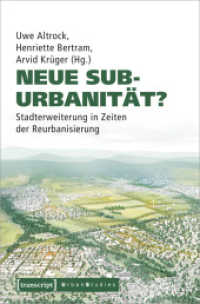Full Description
How do you ensure you're using literacy instruction effectively to meet the needs of all of your students? In this book from Diana and Betsy Sisson, you'll learn an innovative approach to using the literacy block in a gradual release model that allows you to provide grade-appropriate teaching as well as meaningful, individualized instruction to close the academic gaps of struggling learners and offer accelerated experiences for advanced students.
What's Inside
·Part I of the book lays out the authors' framework for the Core Block.
·Part II explains how to use the re-envisioned block to integrate the core components of word study, vocabulary development, strategic reading instruction, writers' craft, and expanded reading opportunities,,
·Part III reveals how to use differentiation, project-based learning, and assessment to prepare students for new literacy demands.
·The appendix provides literacy block schedules, tools for phonics development and morphology study, and correlations to the Common Core.
Each chapter includes practical tools and examples, as well as "In Action" boxes show how the ideas look in an authentic classroom.
Contents
Preface
Meet the Authors
PART I FOUNDATIONS OF LITERACY INSTRUCTION
Chapter 1 Historical Trends in Literacy Instruction
Brief History of Reading Methodology
Origins of the Literacy Block and Guided Reading
Benefits & Challenges of the Literacy Block
Chapter 2 The Core Block
Gradual Release of Responsibility Instructional Model
Overview of Components in the Core Block
Whole-Group Instruction
Word Study
Vocabulary
Comprehension and Fluency
Guided Reading
Small-Group Application
The Core Block "In Action"
Conclusion
PART II COMPONENTS OF THE CORE BLOCK
Chapter 3 Word Study
Significance of Word Study for Literacy Achievement
Phonemic Awareness
Phonics Development
Morphology
Word Study "In Action"
Conclusion
Chapter 4 Vocabulary Development
Significance of Vocabulary for Literacy Achievement
Key Principles for Robust Vocabulary Acquisition
Personalized Vocabulary Study
Vocabulary APP Centers
Vocabulary "In Action"
Conclusion
Chapter 5 Strategic Reading Instruction
Significance of Comprehension for Literacy Achievement
Comprehension APP Centers
Universal Comprehension Strategy Instruction
Standards-Based Strategy Instruction
Prescriptive Strategy Instruction
Integrated Strategy Instruction
Fluency's Role in Comprehending Text
Comprehension Strategies "In Action"
Conclusion
Chapter 6 Writers' Craft
Significance of Writers' Craft for Literacy Achievement
The Reading-Writing Connection
Integrating Writing Instruction in the Classroom
Intentional Planning
Explicit Instruction
Modeled Writing
Shared Writing
Guided Practice
Independent Practice
Targeted Mini-Lessons
Ongoing Conferences
Writers' Craft "In Action"
Conclusion
Chapter 7 Expanded Reading Opportunities
Significance of Expanded Time for Student Reading on Literacy Achievement
Read Aloud
Independent Reading
Book Groups
Extended Reading Opportunities "In Action"
Conclusion
PART III ENSURING STUDENT SUCCESS
Chapter 8 Differentiating Instruction
Individualizing Instruction for Students
Content
Process
Product
Conclusion
Chapter 9 Project-Based Learning
What is Project-Based Learning?
The Power of Project-Based Learning
Misconceptions About Project-Based Learning
Obstacles in Implementing Project-Based Learning
Integration of Projects into Literacy Block
Suggested PBL Study Topics
Conclusion
Chapter 10 Assessment
Attributes of Effective Assessment
Aligned to Instructional Purpose
Reflective of the Learning Process
Flexible to Meet the Needs of Teachers, Students, and the Classroom
Geared to Inform Instruction
Developed as Ongoing Cycle for Teaching and Learning
Screening
Diagnosis
Ongoing Assessment
Outcome Assessment
Varied Means of Assessment
Anecdotal Records
Constructed-Response Assessments
Developmental Spelling Assessments
Early Literacy Assessments
Essays
Informal Reading Inventories
Objective Tests
Oral Reading Fluency Measures
Oral Retelling
Performance Assessments
Portfolios
Rubrics
Running Records
Self-Assessments
Standardized Tests
Conclusion
APPENDIX Appendix A - Literacy Block Schedules
Appendix B - Phonics Development
Appendix C - Morphology Study
Appendix D - Common Core Standards
References







